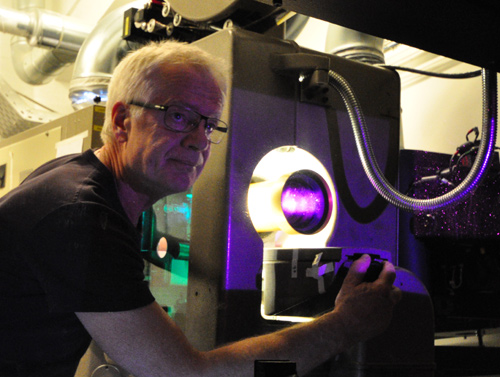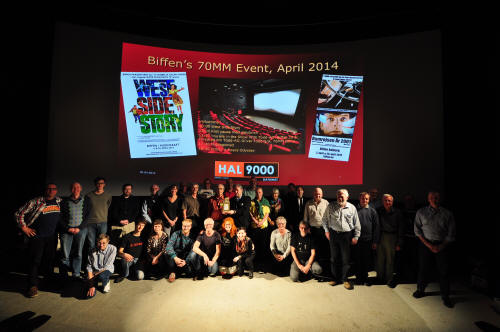Odyssé til Aalborg |
Read more at in70mm.com The 70mm Newsletter |
| Written by: Brian Mac Eochaidhin / Brian Guckian, Ireland | Date: 30.04.2014 |
Rejsen |
|
 The
Biffen in Aalborg. Image by Anders Olsson The
Biffen in Aalborg. Image by Anders OlssonThe small city of Aalborg in the Kingdom of Denmark is situated at the narrowest point of the Limfjord, a body of water that at first appears to the outsider to be the lower course of a river, but is in fact a shallow sound separating the Jutland Peninsula from the Vendsyssel-Thy (North Jutlandic Island). An important crossing point for the main road and rail routes, until recently the city was a location for heavy industry, with accompanying harbour facilities. Latterly it is an increasingly important educational and cultural centre, with major investments made in new venues and amenities. Among these is Nordkraft, an enlightened conversion of the city’s former coal-fired power station into a multi-purpose culture, sports and recreation centre. Contained within the vast interior space of the building are music and theatre venues, restaurants, an art gallery, sports facilities, spaces for classes and workshops, a small business incubation centre, a branch of Aalborg University Library, a tourist office and of course, Biffen Art Cinema. (The writer was interested to learn that Biffen is the Danish word for films / movies). A remarkable achievement has been the creation of three beautifully-designed cinema auditoria within the restrictions of the building, given its load-bearing pillars and mass concrete walls and floor slabs. Each theatre (A, B & C) features curved screens with wide viewing angles and stadium-type seating which is also curved, in the amphitheatre style. Each has film and digital video projection facilities, with cinema A featuring dual DP70 projectors with an accompanying 35/70mm platter for maximum flexibility and capacity. (This came in very useful during the event, when both features and short subjects were shown, in mixed programme format, along with video material). |
More in 70mm reading: 70MM Film Event at Biffen, Aalborg Denmark, 26. April 2014 Aalborg 70mm Film Event Aalborg 70MM Event Gallery Book signing in Aalborg - Johan Wolthuis to attend 70mm Event Todd-AO & Cinerama in Ireland Internet link: biffen.eu SaveFilm.org |
 The
Biffen in Aalborg. Image by Anders Olsson The
Biffen in Aalborg. Image by Anders OlssonThere is also an attractive cafeteria in the foyer, and an upper mezzanine level with an exceptional display of mainly small gauge projectors and cameras, as well as a collection of posters and magazines. This forms a unique small museum attraction that is practically worth visiting on its own account. Having travelled up through the beautiful Danish countryside by comfortable, fast DSB InterCity train from Copenhagen on Friday evening (featuring the spectacular traverse of the Great Belt bridge-tunnel), and having met up with international friends and guests both old and new, the day began with a screening of Jerome Robbins’ and Robert Wise’s classic “West Side Story”. Intriguingly, the film remains as relevant as ever, not least because of its themes, but also on account of its energy and intensity, which gives it an unexpectedly fresh feel: watching it again, it was hard to believe it was made as long ago as 1961. Also enduring is its sheer technical proficiency, both in front of and behind the camera, with outstanding performances, choreography and musical composition matched by the masterly lighting and framing of cinematographer Daniel L Fapp, ASC. Stephen Sondheim’s playful lyrics in Gee, Officer Krupke, with their theme of personal irresponsibility, continue to resonate today too. The involvement of Hollywood legends Saul Bass and Linwood G Dunn in the film’s abstract style photographic effects imparts additional artistic flair to a work already distinguished by remarkable contributions in every area. (It was also gratifying to be able to listen to the film’s soundtrack in its correct “5 across” format of Left, Centre Left, Centre, Centre Right, Right and mono Surround). If there was a common thread between the two main attractions of the day, it was how they both in their own way represented genuine advances and achievement in Cinema technique; even perhaps, a zenith. |
|
Introduktion |
|
 Thomas
Hauerslev & Orla Nielsen. Image by Anders Olsson Thomas
Hauerslev & Orla Nielsen. Image by Anders OlssonThe next section of the programme began with an intoduction and welcome by Biffen Art Cinema owner Orla Nielsen, who then showed a superb documentary he had made about the conversion of the power station and the creation of Nordkraft featuring footage shot over the construction period (including some amazing “aerial” or “telescopic jib”-type footage shot from a moving cradle suspended from one of the tower cranes!) This was followed by equally fascinating shots of the installation of the three cinema auditoria and projection equipment – very impressive, and a great way to “set the scene” for visitors. After this in70mm.com Editor Thomas Hauerslev gave an absorbing lecture entitled The Early Days of Todd-AO, covering in detail the work by Fred Waller into peripheral vision and the beginnings of Cinerama, and the subsequent development of Todd-AO, arising out of producer and showman Mike Todd’s desire for a process that would “have the impact of Cinerama, but none of its limitations”. The thorough account given of Mike Todd’s association with the American Optical Company, and its Research Center headed by Dr. Brian O’Brien, assisted by Dr. Walter P. Siegmund, Brian O’Brien, Jr. and others, recalls the heady “can do” and “go for it” culture of the post-war era. The incorporation of the Magna Theatre Corporation on 27 November 1952 to one of the first test screenings at the Regent Theatre in Buffalo, New York on 8 August 1953 in the space of just nine months was a remarkable achievement, all the more so given the scale of the task – development of the camera system, lenses and projector, and in time, processing, printing, sound and editing equipment and related accessories. The curved screen and 70mm projection facilities in Biffen’s cinema A provided an ideal setting for screenings of the Todd-AO demonstration films "The Miracle of Todd-AO" and "The March of Todd-AO". The wide viewing angle along with the 132 degree Bug Eye lens photography provided a highly effective “immersive” experience – something that has regrettably been lost today across all formats, due to the dominance of flat screens and generally much narrower lens angles (IMAX being the closest equivalent). In a very nice gesture, as part of this educational section of the programme, Thomas Hauerslev was presented with an award by Johan Wolthuis of International 70mm Publishers in gratitude for his promotion of 70mm and Widescreen Cinema over many years, and his contributions to the study of the field, which was accepted with humour and appreciation. |
|
Opdagelse |
|
 Oliver
Michael Todd. Image by Anders Olsson Oliver
Michael Todd. Image by Anders OlssonThe event was honoured to have present, as a special guest, Oliver Todd, grandson of Mike Todd and son of Mike Todd Jr., who coincidentally today lives and works in Copenhagen. In an engaging and informative interview, Mr. Todd recalled the work of his father and his upbringing in rural Ireland, where the family had moved in the 1960s, and the legacy of Mike Todd. It was interesting to learn more about Mike Todd Jr.’s lesser-known projects such as an adaptation of Sylvia Plath’s “The Bell Jar” and a planned production with Richard Burton that was sadly halted by the latter’s untimely death. Oliver Todd also related experiences trying to get work in the film industry against the advice of his father until realising that indeed it was not for him. Appropriately, given the educational aspects of the event, he now works as a teacher, far removed from that other world. This middle section of the day concluded with some more extracts and clips, including the somewhat "corny" but nevertheless highly effective 70mm trailer for 1992's "Far and Away", shot by the noted Danish cinematographer and latterly, filmmaker, Mikael Salomon. Another treat was the screening of some 70mm test reels from the 1960s that recalled, along with the other films shown, a period of very high quality production values in Cinema across all its different crafts. A long break for Dinner allowed for much reflection and discussion, both Cinema and non-Cinema related. It is always a privilege to meet people from other cultures and countries, brought together by a shared interest, and to learn more about their perspectives and experiences. |
|
Hinsides Det Uendelige |
|
 Ben
Wales (UK) and Brian Walters (Australia). Image by Anders Olsson Ben
Wales (UK) and Brian Walters (Australia). Image by Anders Olsson“Aalborg. Biffen. Kubrick.” – now, the highlight of the event for this writer: an opportunity to again experience An epic drama of adventure and exploration (even that being a somewhat modest description). As with “West Side Story” before, this meisterwerk of the Cinema seems to become more relevant with the passage of time, no less so in today’s era of high technology and what does seem to be a increasing diminishment of the human (when people themselves start referring to “human beings”, should we be worried?) While attention is always given to Kubrick’s astonishing accomplishments, and that of his collaborators in the film’s photographic effects and cinematography, the contribution of renowned science fiction writer, polymath and visionary Arthur C Clarke cannot be overlooked, as his short story The Sentinel gives the film its central philosophical themes and direction. Although by all accounts not religious, it is clear that Clarke was concerned with the “big” questions of the origins and ultimate destiny of humanity. “2001: A Space Odyssey” perhaps represents the definitive marriage of the technical arts and crafts of Cinema with these intellectual ideas, considerably expanding the potential of the medium at the time. |
|
HAL 9000 |
|
 Orla
and the DP70. Image by Thomas Hauerslev Orla
and the DP70. Image by Thomas HauerslevMany followers of Cinema will be aware that the motion picture artform is now regrettably in danger of disappearing due to the relentless spread of binary (digital), causing recent worrying closures of film laboratories, reduced ranges of film stocks, and the demise of several film projection and related equipment manufacturers. An international movement, SaveFilm.org, has now been established in order to preserve the unique and culturally important motion picture filming and projection experience. They carry much useful information and insights and are hosting a Petition which those around the world who appreciate the value and importance of Film can sign. It is recommended that this initiative be supported so that there is some hope of maintaining screenings of classic films, not just in 70mm but in other gauges too, in the interests of world culture, history and heritage. |
|
Epilog |
|
 "Family
photo" of the day in front of the curved screen.
Image by Thomas Hauerslev "Family
photo" of the day in front of the curved screen.
Image by Thomas HauerslevClick the picture to see the enlargement A visit to beautiful Denmark, Aalborg and Biffen Art Cinema is a must for those who appreciate film – not just the stories and personalities on screen, but also to witness best practice in cinema design and presentation, and to learn more about Cinema history and heritage. On a promising note, from the large attendances and number of young people, it was clear that there is an enduring interest in this area, and also an appetite for knowledge and education about it, and this can certainly be developed. It was a privilege to be able to attend, and sincere thanks are due to Orla Nielsen and his Staff for their hospitality, and for putting on a marvellous Show. |
|
| Go: back - top - back issues - news index Updated 22-01-25 |
